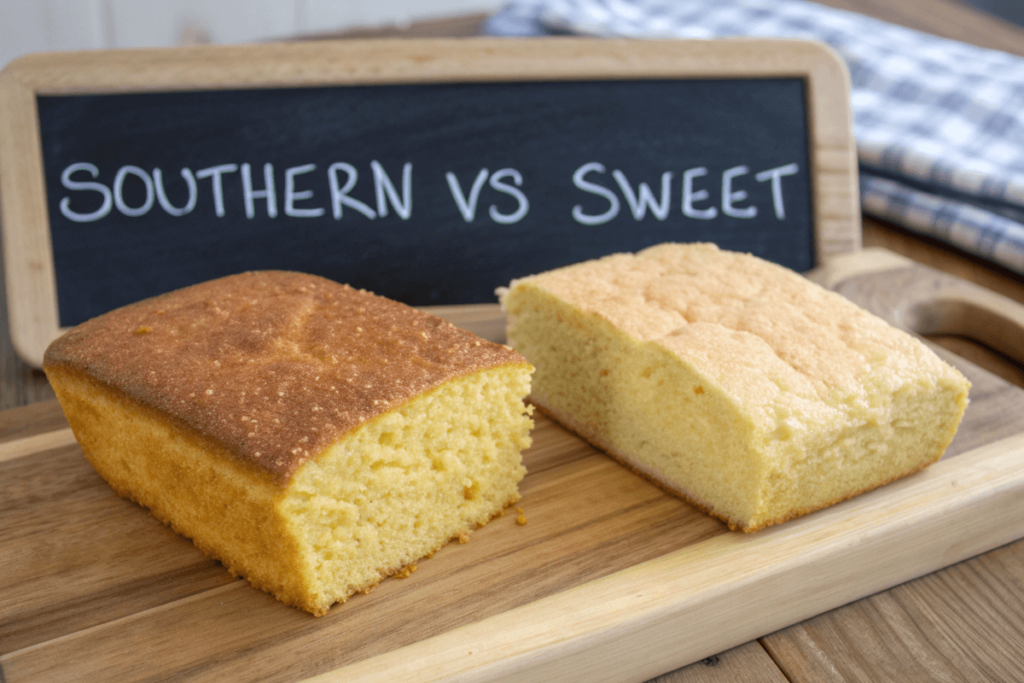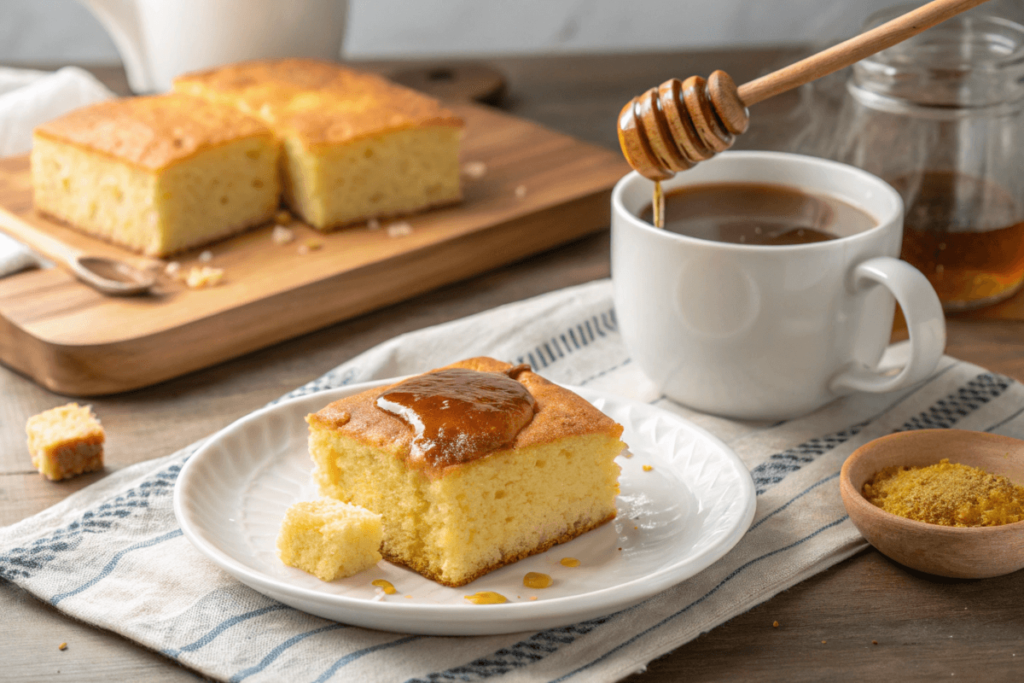Cornbread is more than just bread—it’s a slice of cultural history, especially in the Southern United States. But Southern cornbread vs sweet cornbread sparks debate, as they are not created equal. From their ingredients to their textures and even their cultural significance, these two variations are distinct in many ways. In this article, we’ll explore the origins, ingredients, flavors, and cooking techniques that set these two beloved dishes apart. Whether you’re a fan of the savory or the sweet, this guide will help you appreciate the nuances of both styles.
Origins and History
Historical Roots of Cornbread
Cornbread’s story begins with Native Americans, who relied heavily on cornmeal as a staple in their diet. This resourceful ingredient became the foundation for cornbread, an early type of bread that required few additional components. When European settlers arrived, they adopted the practice of using cornmeal, especially in the South, where corn grew abundantly.
By the 18th and 19th centuries, Southern cornbread vs sweet cornbread became a distinction rooted in tradition and resources. Southern cornbread solidified its role as a savory staple, reflecting the simplicity of its recipe, which made it accessible to all social classes, from plantation kitchens to rural households. What set it apart was its lack of sugar, aligning with the savory preferences of the region.
Evolution of Sweet and Southern Cornbread
Meanwhile, in other parts of the country, cornbread began to evolve. In regions where sugar was more readily available and palates leaned sweeter, sweet cornbread emerged. Over time, this version became a favorite in parts of the Midwest and Northeast, served as a side dish for holiday meals or enjoyed as a dessert.
Southern cornbread, on the other hand, remained deeply rooted in tradition. It became more than just food—it symbolized the resilience and resourcefulness of Southern communities. Whether baked in a cast-iron skillet or paired with collard greens and black-eyed peas, its savory flavor highlighted the cultural pride of the South.
Cornbread may have started as a utilitarian food, but its history is rich with cultural significance. The debate over Southern cornbread vs sweet cornbread continues, but both styles offer a delicious snapshot of America’s culinary past.
Key Ingredients Comparison
Essential Ingredients of Southern Cornbread
When discussing Southern cornbread vs sweet cornbread, simplicity sets Southern cornbread apart. Its recipe often skips flour entirely, relying solely on cornmeal for structure. This choice gives Southern cornbread its signature crumbly texture. Unlike sweet cornbread, sugar is notably absent, aligning with the savory preferences of traditional Southern cuisine. Instead of butter, many classic Southern recipes use bacon grease or lard, which adds a smoky depth to the flavor.
Another hallmark of Southern cornbread is buttermilk. This key ingredient enhances the bread’s tangy profile while contributing to a moist interior that balances the crunch of the skillet-toasted crust. Eggs and baking soda are added to ensure the bread rises beautifully while maintaining its hearty texture.
For those seeking authentic Southern cornbread, understanding these ingredient choices is crucial to appreciating what is the difference between Southern cornbread and sweet cornbread.
Sweet Cornbread Ingredients
Sweet cornbread takes a distinctly different route, appealing to those who enjoy a touch of sweetness. Flour is often combined with cornmeal to create a softer, less gritty texture. The addition of sugar or honey transforms the flavor, making sweet cornbread ideal as a versatile side dish or even a light dessert.
Butter plays a central role in sweet cornbread recipes, providing a rich and velvety finish. Unlike the tangy buttermilk used in Southern cornbread, sweet cornbread typically incorporates regular milk or cream for a neutral flavor. Baking powder is also more common in sweet cornbread, creating a lighter, cake-like texture that appeals to a broader audience.
Whether you lean toward the savory or the sweet, it’s clear that the ingredients used in each style define their unique characteristics. The next time you think about what is the difference between Southern cornbread and sweet cornbread, remember that it all begins with the choices made in your kitchen.

Cooking Techniques and Methods
Preparation of Southern Cornbread
Cooking Southern cornbread vs sweet cornbread reveals a striking difference in techniques. Southern cornbread typically begins with a preheated cast-iron skillet, an essential tool for achieving the crispy crust that defines this dish. A thin layer of bacon grease or oil is heated until it sizzles, ensuring the perfect non-stick surface while infusing the cornbread with rich flavor.
The batter is poured directly into the hot skillet, instantly forming a golden crust. The bread is then baked in a high-temperature oven, ensuring even cooking and a moist, crumbly interior. Some cooks broil the top briefly to add an extra crunch, enhancing the rustic appeal of this savory favorite.
Cooking Sweet Cornbread
Sweet cornbread, on the other hand, uses a more forgiving method. It is often baked in a standard baking dish or muffin tin, and the process does not require a preheated pan. The batter, which is wetter and softer than Southern cornbread, is poured into the dish and baked at a moderate temperature. This approach produces a golden, fluffy bread with a soft, cake-like texture.
Many recipes suggest finishing sweet cornbread with a drizzle of honey or a pat of butter while it’s still warm, enhancing its subtle sweetness. These simple touches elevate sweet cornbread to a versatile dish that can complement spicy meals or double as a dessert.
Highlighting the Contrast
The distinct cooking techniques underscore the contrasting nature of Southern cornbread vs sweet cornbread. Southern cornbread embraces a rustic, savory approach, while sweet cornbread leans toward convenience and flexibility. Yet both remain true to their roots, delivering comfort and flavor with every bite.
This side-by-side comparison makes the question, what is the difference between Southern cornbread and sweet cornbread, easy to answer.
Flavor and Texture Profiles
The Tangy, Crumbly Nature of Southern Cornbread
Southern cornbread stands out for its bold, savory flavor and distinct texture. Made primarily with cornmeal and buttermilk, it has a tangy bite that pairs wonderfully with rich Southern dishes like collard greens and black-eyed peas. The lack of sugar lets the natural taste of the cornmeal shine, making it a perfect side dish for hearty meals.
The texture is crumbly yet dense, thanks to the absence of flour in many recipes. When cooked in a cast-iron skillet, Southern cornbread develops a crispy, golden crust that provides a delightful contrast to its soft interior. This combination of flavors and textures makes it a staple in Southern cuisine.
For more ideas on pairing Southern cornbread, explore this guide to traditional Southern dishes.
Sweet Cornbread’s Appeal
In contrast, sweet cornbread is soft, fluffy, and slightly cake-like. The added sugar or honey creates a subtle sweetness that complements a wide range of dishes, from spicy chili to savory barbecue. Its texture is smoother and less crumbly than Southern cornbread, thanks to the use of flour.
Sweet cornbread is versatile—it’s equally delightful as a side dish or a light dessert. Warm from the oven, it’s often served with a drizzle of honey or a smear of butter, enhancing its sweetness and appeal.
When considering what is the difference between Southern cornbread and sweet cornbread, flavor and texture are key distinctions. Southern cornbread is bold and rustic, while sweet cornbread is soft and approachable, catering to a broader audience.

Cultural and Regional Variations
Regional Takes on Southern Cornbread
Southern cornbread has many regional twists, reflecting the diversity of the South. In Appalachia, cooks often use stone-ground cornmeal, which creates a coarser, more textured bread. Bacon drippings are a common addition, reinforcing its savory essence.
In contrast, Texas cornbread frequently incorporates jalapeños or cheddar cheese, adding a spicy kick that highlights the bold flavors of Tex-Mex cuisine. These variations demonstrate how local ingredients and preferences shape the dish.
Sweet Cornbread Across the U.S.
Sweet cornbread also showcases regional differences. In New England, it’s sometimes made with molasses for a deeper sweetness and richer flavor. In the Midwest, sweet cornbread is often served during holiday feasts alongside turkey and cranberry sauce, blending with other festive dishes.
These regional interpretations show how cornbread adapts to cultural and geographical influences. Whether you prefer the rustic charm of Southern cornbread or the delicate sweetness of its Northern counterpart, each version tells a unique story.
Serving Suggestions
Pairing Southern Cornbread with Traditional Dishes
Southern cornbread is a perfect companion to the hearty flavors of traditional Southern cuisine. Its savory and crumbly texture complements dishes like collard greens, fried chicken, and black-eyed peas. Served warm from a cast-iron skillet, it’s often accompanied by a smear of butter for an added layer of richness.
One popular way to enjoy Southern cornbread is to crumble it into a bowl of chili or bean stew, where its dense texture soaks up the flavors. For breakfast, many Southerners dip slices of cornbread into a glass of buttermilk, creating a tangy, comforting treat.
These serving traditions highlight the rustic, versatile nature of Southern cornbread. The next time you’re wondering what is the difference between Southern cornbread and sweet cornbread, remember that serving style plays a major role in how each is enjoyed.
Sweet Cornbread as a Versatile Side
Sweet cornbread shines in its adaptability. Its fluffy texture and mild sweetness make it an excellent side dish for barbecue, spicy chili, or roasted vegetables. It can also double as a dessert when served with honey, maple syrup, or whipped cream.
For special occasions, some cooks transform sweet cornbread into muffins or use it as a base for a cornbread pudding. These creative twists make sweet cornbread a favorite for holidays and family gatherings, where its tender crumb is a hit with all ages.
Traditional vs. Modern Adaptations
Classic Southern Cornbread Recipes
Traditional Southern cornbread recipes rely on minimal, straightforward ingredients: cornmeal, buttermilk, eggs, and bacon grease. This simplicity reflects the resourcefulness of Southern cooks, who valued practicality and bold flavors.
Over time, traditional Southern cornbread has remained largely unchanged, treasured for its authenticity. Its dense, savory profile continues to evoke a sense of nostalgia and connection to Southern culinary roots.
Modern Twists on Sweet Cornbread
Modern sweet cornbread, however, has seen many adaptations to suit contemporary tastes. Some recipes add ingredients like cheese, jalapeños, or corn kernels for extra flavor and texture. Others experiment with gluten-free flours or natural sweeteners like agave syrup to cater to dietary preferences.
These innovations make sweet cornbread more accessible to a wider audience, while still honoring its comforting essence. When thinking about what is the difference between Southern cornbread and sweet cornbread, the contrast between tradition and creativity is striking. Southern cornbread remains steadfastly loyal to its roots, while sweet cornbread evolves with the times.
Both styles offer a unique take on a beloved dish, proving that cornbread is as versatile as it is delicious. Let me know when you’re ready to continue with the next parts!
The Health Perspective
Nutritional Comparison
When exploring what is the difference between Southern cornbread and sweet cornbread, health considerations can be a deciding factor. Southern cornbread, with its minimal ingredients, tends to be lower in sugar and calories. The use of bacon grease or lard, however, adds more saturated fat compared to butter or oil in sweet cornbread.
Sweet cornbread, on the other hand, contains added sugars or sweeteners, which can increase its calorie content. The inclusion of flour in many recipes also adds carbohydrates, giving it a slightly higher glycemic index than its Southern counterpart.
Gluten-Free and Health-Conscious Alternatives
Both types of cornbread can be adapted for health-conscious eaters. Southern cornbread is often naturally gluten-free when made without flour, making it a great option for those with gluten sensitivities. Sweet cornbread can be made healthier by using alternative flours, such as almond or oat, and substituting sugar with honey or maple syrup.
These adjustments allow cornbread lovers to enjoy their favorite style while keeping an eye on their dietary needs. Whether you prefer the rustic appeal of Southern cornbread or the dessert-like sweetness of its counterpart, both can fit into a balanced diet.
FAQs and People Also Ask
Why Is Sugar Omitted in Southern Cornbread?
Southern cornbread is traditionally savory, emphasizing the natural flavor of cornmeal. Historically, sugar was less common in Southern households, which likely influenced the absence of sweetness in these recipes.
Can Sweet Cornbread Be Made Savory?
Absolutely! By reducing or omitting sugar and incorporating ingredients like cheddar cheese, jalapeños, or herbs, sweet cornbread can take on a savory profile. This hybrid approach bridges the gap between the two styles.
What Are the Best Dishes to Serve with Cornbread?
Southern cornbread pairs well with hearty dishes like chili, black-eyed peas, and fried chicken. Sweet cornbread complements spicy foods like barbecue or can be served as a dessert alongside honey and cream.
How Do You Get the Perfect Crust on Southern Cornbread?
To achieve that iconic golden crust, preheat a cast-iron skillet with a layer of bacon grease or oil. Pour the batter into the hot skillet and bake immediately. The sizzling pan creates a crispy, flavorful crust.
This detailed comparison answers what is the difference between Southern cornbread and sweet cornbread? while providing practical tips for enjoying both styles. Let me know if you’d like to refine or expand on any sections!


1 thought on “What is the difference between southern cornbread and sweet cornbread?”